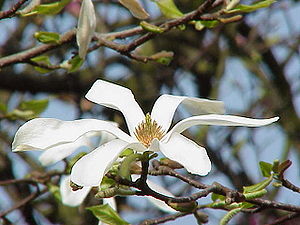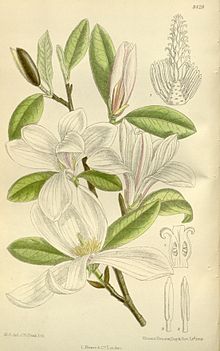Kobushi magnolia
| Kobushi magnolia | ||||||||||||
|---|---|---|---|---|---|---|---|---|---|---|---|---|

Kobushi magnolia ( Magnolia kobus 'Borealis') |
||||||||||||
| Systematics | ||||||||||||
|
||||||||||||
| Scientific name | ||||||||||||
| Magnolia kobus | ||||||||||||
| DC. |
The Kobushi magnolia ( Magnolia kobus ) is a species of plant that belongs to the genus of magnolias ( Magnolia ) within the magnolia family (Magnoliaceae). It originally comes from Japan and is called there in Japanese 辛夷 Kobushi . It is used as an ornamental plant.
description
The Kobushi magnolia is a deciduous, medium-sized tree that can reach heights of up to 24 meters. It develops a straight, continuous trunk that is covered by a rough, brown or silver-gray bark . The bark of young twigs is yellow-green and hairy ( indument ). The buds are hairy yellow or silver.
The leaves are divided into a petiole and a leaf blade. The petiole is hairy. The simple leaf blade is 10 to 20 centimeters long and obovate and has entire margins. The underside of the leaf is lighter.
The Kobushi magnolia only begins to bloom after several years and only reaches its full bloom at 10 to 30 years of age. The main flowering time of the Kobushi magnolia is from March to April, before the leaves shoot . Its flowers develop from the terminal buds. The fragrant, hermaphrodite flowers are white on the inside and shimmering pink on the outside. Each flower contains nine or twelve narrow tepals , the outer three are greenish and 3 centimeters long, the inner ones have a length of 5 to 8 centimeters. There are numerous stamens, pink to purple at the base, and numerous pistils .
With a length of 5 to 13 centimeters, the pelvic fruit is cylindrical at first and then turns red-brown at first. The seeds are surrounded by a red seed coat ( arillus ).
The number of chromosomes is 2n = 38.
distribution
The Kobushi magnolia comes from Japan, where it is found in mountain forests on all of the main islands except Shikoku . It is also widespread on the island of Jeju-do , which belongs to South Korea . The distribution area does not overlap with the related star magnolia .
use
The most important use in the temperate latitudes is as an ornamental wood . Wood is also used in Japan . There are some selected varieties and hybrids .
Varieties of Kobushi magnolia (selection):
- 'Borealis' group - hardy, fast-growing, large plants from the north of the range.
- 'Fastigiata' - weakly growing and columnar, already selected in Japan in 1925.
- 'Norman Gould' - polyploid shape, flowers larger, petals thicker.
Hybrids with the Kobushi magnolia:
- Magnolia kobus × Magnolia stellata = Magnolia × loebneri , in the properties between the parent species. This cross is not known from nature, since the distribution areas of the two species do not touch. This cross was first achieved by Max Loebner from Pillnitz and named Magnolia × loebneri by Paul Kache in 1920 . In 1923, the Kordes tree nursery acquired some of the plants from Loebner, and since then numerous other varieties have been produced with these parents, such as 'Leonard Messel' and 'Merrill'.
- Magnolia kobus × Magnolia salicifolia = Magnolia × kewensis , the hybrid of these closely related species was first discovered by chance in 1938 in Kew Gardens. It also occurs naturally in Japan.
- Magnolia kobus × Magnolia liliiflora , obtained at the Brooklyn Botanical Garden by Evamaria Sperber, triploid hybrid.
Systematics and botanical history
Within the genus Magnolia , the Magnolia kobus is classified in the sub-genus Yulania , there in the section and subsection Yulania . Related species are, for example, the star magnolia , Magnolia salicifolia and Magnolia biondii . A separate section for these species ( Buergeria ) is no longer maintained.
The first description was given by de Candolle in 1817 under the name kobus , because Kaempfer had given this (not quite correctly) as the Japanese name of this tree. Specimens from the north of the range were described by Sargent as a borealis variety , but the characteristics he describes cannot be assigned to a specific population, there is a smooth transition. The name is occasionally found in tree nurseries, however, as these plants (better known as the 'Borealis' variety group) are characterized by their stronger growth. The star magnolia ( Magnolia stellata ) is sometimes also considered a variety of the Kobushi magnolia ( Magnolia kobus var. Stellata ).
Individual evidence
- ↑ Rafaël Govaerts (ed.): Magnolia kobus. In: World Checklist of Selected Plant Families (WCSP) - The Board of Trustees of the Royal Botanic Gardens, Kew . Retrieved September 25, 2019.
- ^ Classification of Magnoliaceae. Magnolia Society International, 2012, accessed December 22, 2015 . , see. RB Figlar, HP Nooteboom: Notes on Magnoliaceae IV. In: Blumea. Leiden 49,2004,1,87. ISSN 0006-5196
literature
- DJ Callaway: The World of Magnolias. Timber Press, Portland Or 1994, pp. 154ff. ISBN 0-88192-236-6


